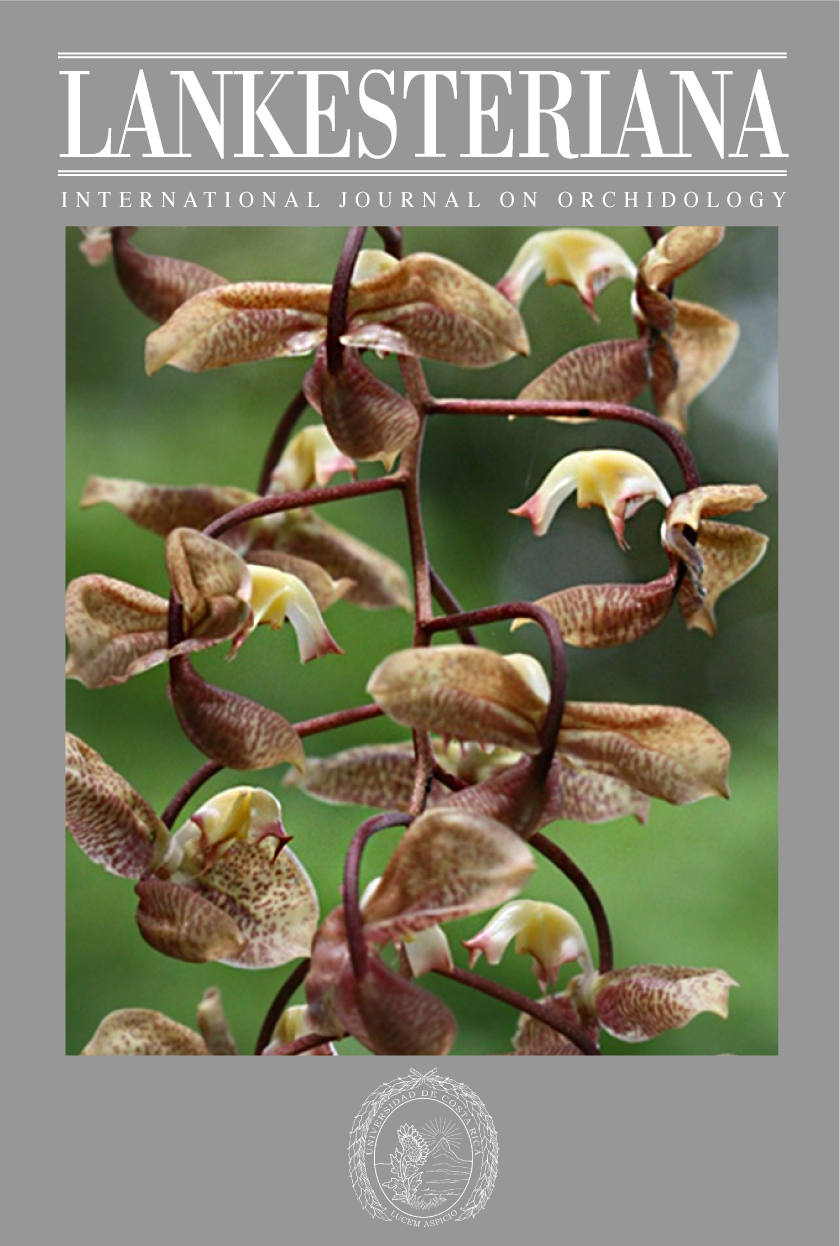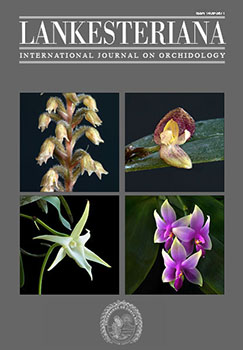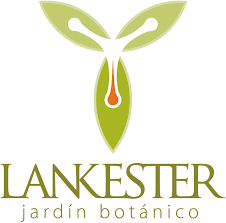First record of a natural hybrid of the genus <i>Gongora</i> (Stanhopeinae) and comments on the parent species
DOI:
https://doi.org/10.15517/lank.v23i1.54261Palabras clave:
Copán, Cymbidieae, Euglossini, Gongora cassidea, Gongora saccata, Honduras, OrchidaceaeResumen
Se describe el primer híbrido natural descubierto del género Gongora, entre las especies Gongora truncata y Gongora batemanii (sinónimo: Gongora cassidea). La notoespecie que aquí se describe presenta caracteres intermedios entre ambas especies, como las proyecciones setáceas en el labio, un callo grande, el epiquilo espatulado y el sépalo dorsal fuertemente cuculado. También se discute la identidad de un ejemplar del Herbarium Jany Renz Botanical Institute, University of Basel, Suiza, el cual corresponde al mismo híbrido aquí descrito, erróneamente determinado como Gongora saccata, el cual es un sinónimo de Gongora seideliana. Se discute también la aclaración de la sinonimia de Gongora saccata, y aspectos de relevancia en cuanto a los mecanismos de polinización y barreras reproductivas de ambas especies parentales.
Descargas
Citas
Ackerman J. D. (1989). Geographic and seasonal variation in fragrance choices and preferences of male euglossine bees. Biotropica, 21(4), 340–347. DOI: https://doi.org/10.2307/2388284
Ames, O. & Correll, D. S. (1953). Orchids of Guatemala. Fieldiana: Botany, 26(1).
Ames, O. & Correll, D. S. (1985). Orchids of Guatemala and Belize. Courier Corporation.
Beutelspacher, C. R. (2011). Guía de orquídeas de Chiapas. México: Universidad de Ciencias y Artes de Chiapas.
Chase, M. W., Toscano de Brito, A. L. V., Pridgeon, A. M., Cribb, P. J., Chase, M. W. & Rasmussen, F. N. (2009). Genera Orchidacearum, Volume 5: Epidendroideae (Part Two). Oxford: Oxford University Press.
Damon, A., Hernández-Ramírez, F., Riggi, L., Verspoor, R., Bertolini, V., Lennartz-Walker, M. & Burns, A. (2012). Pollination of euglossinophylic epiphytic orchids in agroecosystems and forest fragments in southeast Mexico. European Journal of Environmental Sciences, 2 (1), 5–14. DOI: https://doi.org/10.14712/23361964.2015.34
Dressler, R. L. (1968). Pollination by euglossine bees. Evolution, 22 (1), 202–210. DOI: https://doi.org/10.2307/2406664
Dressler, R. L. (1993). Phylogeny and classification of the orchid family. Cambridge University Press.
Eltz, T., Whitten, W. M., Roubik, D. W. & Linsenmair, K. E. (1999). Fragrance collection, storage, and accumulation by individual male orchid bees. Journal of Chemical Ecology, 25 (1), 157–176. DOI: 10.1023/A:1020897302355
Faegri, K. & Van Der Pijl, L. (2013). Principles of pollination ecology. Pergamon press.
García-Martínez, R. & Jiménez-Machorro, R. (2016). Redescubrimiento de Gongora seideliana Rchb.f. (Orchidaceae), una orquídea rara, en Chiapas, México. Lacandonia, 10 (2), 11–14.
Gerlach, G. (2003). La subtribu Stanhopeinae: sus notables mecanismos de polinización, la química de sus aromas florales e implicaciones en sistemática y taxonomía. Lankesteriana, 7, 104–106. DOI: 10.15517/lank.v3i2.23029
Gershenzon J. (1994). Metabolic costs of terpenoid accumulation in higherplants. Journal of Chemical Ecology, 20, 1281–1328. DOI: 10.1007/BF02059810
Grant, V. (1981). Plant Speciation. New York: Columbia University Press.
Hágsater, E. & Salazar, G. A. (1990). lcones Orchidacearum. Fascicle I. Orchids of Mexico Part, 1. México City: Herbario AMO. 45 pp.
Hetherington-Rauth, M. C. & Ramírez, S. R. (2015). Evolutionary trends and specialization in the euglossine bee-pollinated orchid genus Gongora. Annals of the Missouri Botanical Garden, 100 (4), 271–299. DOI: 10.3417/2014035
Hetherington-Rauth, M. C. & Ramírez, S. R. (2016). Evolution and diversity of floral scent chemistry in the euglossine bee-pollinated orchid genus Gongora. Annals of botany, 118 (1), 135–148. DOI: 10.1093/aob/mcw072
Jenny, R. (1993a). Stanhopea in Costa Rica & Panama. Schlechteriana, 4, 66–92.
Jenny, R. (1993b). Monograph of the genus Gongora Ruiz & Pavon. Koeltz Scientific Books.
Pupulin, F. (2007). × Bensteinia ramonensis, a new natural hybrid in the Zygopetalinae (Orchidaceae). Selbyana, 28 (2), 112–116.
Ramírez, S. (2019). Pollinator specificity and seasonal patterns in the euglossine bee-orchid mutualism at La Gamba Biological Station. Acta ZooBot Austria, 156, 171–181.
Roubik, D. W. & Hanson, P. E. (2004). Abejas de orquídeas de la América tropical: Biología y guía de campo. Editorial INBio.
Soltis, P. S. & Soltis, D. E. (2009). The role of hybridization in plant speciation. Annual review of plant biology, 60, 561–588. DOI: 10.1146/annurev.arplant.043008.092039
van der Pijl, L. & C. H. Dodson. (1966). Orchid flowers, their pollination and evolution. University of Miami Press. 214 pp.
Williams N. H. & Dodson C. H. (1972). Selective attraction of male euglossine bees to orchid floral fragrances and its importance in long distance pollen flow. Evolution, 26, 84–95. DOI: https://doi.org/10.2307/2406985
Williams, N. H. & Whitten, W.M. (1983). Orchid Floral Fragrances and the Male Euglossine Bees: methods and advances. Biological Bulletin, 164, 355–395. DOI: 10.2307/1541248

Descargas
Publicado
Versiones
- 2023-02-28 (2)
- 2023-02-27 (1)
Cómo citar
Número
Sección
Licencia
Derechos de autor 2023 Jardín Botánico Lankester, Universidad de Costa Rica

Esta obra está bajo una licencia internacional Creative Commons Reconocimiento-NoComercial-SinObraDerivada 3.0.
Conforme con las Políticas de Acceso Abierto promovidas por la Universidad de Costa Rica, los derechos de autor de todos los artículos publicados en Lankesteriana se encuentran bajo una licencia Creative Commons y pueden ser descargados gratuitamente. Los derechos de autor y de publicación pertenecen a la revista bajo la licencia CC BY-NC-ND 3.0 CR.
Before the publication of the materials submitted by the author(s) in LANKESTERIANA, the author(s) hereby assign all rights in the article to the Lankester Botanical Garden.




